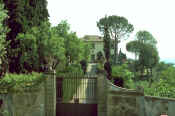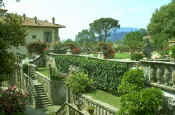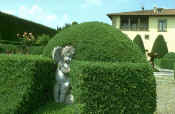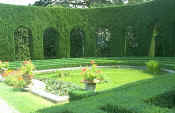|
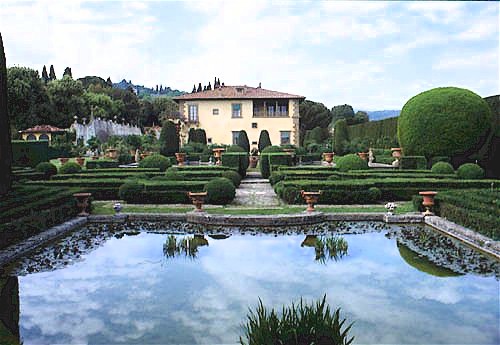
A brief history of Villa Gamberaia
The Villa Gamberaia is located on the hillside of
Settignano, with extraordinary views of Florence and the surrounding
Arno
valley. It is renowned for its splendid gardens, which are celebrated throughout the world by leading landscape architects and garden historians.
The villa was completed in the early seventeenth century by the Florentine noble Zanobi Lapi in the Tuscan style,
and combines interesting architectural features of both an urban palazzo and suburban villa. In the
18 C, the property belonged to the Marchesi Capponi, and by that time the house and gardens had acquired the characteristic elements seen in the famous engraving by Giuseppe Zocchi (1744): the cypress
allée, bowling green, nymphaeum, grotto garden, boschi, parterre and lemon terrace.
At the end of the nineteenth century, Princess Giovanna Ghika began the transformation of the parterre de broderie into the beautiful parterre
d'eau, enclosed at its southern end by a majestic cypress arcade. Elegant expressions of topiary art were created by the American-born Mathilda Ledyard Cass, Baroness von
Ketteler, in the following decades. After the Second World War, the villa became the property of Marcello Marchi and then of his heirs Luigi Zalum and family, who have continued the work of restoration and conservation.
The interior decoration of the Villa is by the Countess Simonetta Paulucci di
Calboli.
The Gardens of Villa Gamberaia
Among the outstanding gardens of Tuscany, few have retained through the course of four centuries as much of their original design and distinctive character as Villa Gamberaia. From the first decades of the 17 C, when the wealthy Florentine merchant Zanobi Lapi built an imposing villa on the hillside of Settignano (1610–1630), on the foundations of a pre-existing casa da signore, and his nephews laid out the main areas of the garden, generations of owners have maintained and improved the property without significantly modifying its basic plan. Whether we contemplate the solid, serene forms of the Tuscan architecture, move through the still clearly-defined garden spaces and levels, stroll through the century-old ilex woods or along the cypress allée, or gaze into the long, sweeping vistas, there is a sense of permanence that pervades the landscape. Even in the parterre d’eau, where the most dramatic changes appear to have been made, one can detect the persistent traces of the past.
Our sources, though not numerous, provide valuable testimony of this continuity. Documents from the Lapi period of the 1620s mention specific garden spaces that were beginning to take shape and can still be identified - a lawn area and ball or bowling court, a space known as “the oak” and the limonaia. Other documents refer to frequent disputes over water rights between the Lapi family and their neighbors, indications that the owners were creating an extensive system of fountains and conduits, from the nymphaeum and the lemon terrace to the gabinetto rustico and parterre. This is serious stuff: Tuscans are still ready to kill today for their water rights.
The earliest graphic sources, nevertheless, belong to the first half of the 18 C: a detailed estate map or cabreo and two etchings by Giuseppe Zocchi. The estate map, which recorded additions and improvements made to the property after it had come into the possession of the marchesi Capponi (c.1718–25), shows in some detail the plan of the villa and gardens, as well as the surrounding farm lands and houses, and depicts in elevation the most prominent architectural elements, notably the west and south façades of the villa padronale, the gabinetto rustico decorated with urns and busts of the seasons, and the nymphaeum of Neptune, as well as the new French-style parterre de broderie. The original layout of the garden spaces determined the strong axial organization of the villa. The principal north-south axis unfolds in two parallel sequences: the path descending from the paretaio (a place for catching small birds) and continuing, on the opposite side of Via del Rossellino, up the entrance drive to the main house and the long garden avenue stretching from the nymphaeum to the belvedere overlooking the Arno valley. The shorter east-west axis runs through the gabinetto rustico, crosses the “street in the garden,” and continues, visually, through the vestibule, interior courtyard, and salone of the house to the terrace overlooking Florence.
The two etchings by Giuseppe Zocchi from 1744 represent other characteristic features of the architecture and site plan still visible today. A view of the villa shows the position of the entrance gate, perpendicular to the road from Settignano, and rows of recently planted cypresses lining the north end of the garden avenue and the entrance. In a perspective view of the villa from the north-west, we see the terraced slopes on which the gardens are laid out: the main terrace on which the villa padronale stands and which continues southward to the end of the parterre and, behind the chapel, part of the upper level or lemon terrace, crowned by the limonaia. On the lower, or agricultural, level of the villa, where the service road runs along the base of the main terrace, a door leads into the basement rooms where farm equipment and implements were (and still are) stored, along with olive oil and wine. The terrain slopes gently downwards, planted with neat rows of olive trees.
A comparison of these plans and views to modern photographs and drawings reveals that relatively few changes have taken place in the last two centuries: for example, the addition of a small building joining the house inside the entrance gate (the Palazzina degli Huomini Neri, as it is called on the cabreo plan ) and the chapel; the opening of a door on the north façade of the villa; and the disappearance of the row of cypresses that continued the line of the arcade (attached to the façade of the main house) to the southern end of the garden avenue. The most notable change has occurred in the parterre, where the Romanian Princess Jeanne Ghyka, shortly after purchasing the villa in 1896, began transforming the space into a spectacular water garden, replacing what was left of the old flower beds with four rectangular pools framed by box and colorful borders of irises, lilies, tree roses, and oleanders. At the southern terminus, in the space where the Capponi cabreo shows an oval conigliera or rabbit island, a pool of water lilies and aquatic plants was enclosed by a cypress arcade or “green theatre.”
The parterre was further modified in the years from circa 1925–1938 by Baroness von Ketteler, the American-born Maud Cass Ledyard, who shifted the emphasis to a more formal, architectonic garden dominated by evergreen borders of box and yew, clipped in elegant topiary forms. A close comparison of the Capponi estate map and Zocchi’s etching with twentieth-century drawings by H. Inigo Triggs (1906), Edward G. Lawson (c.1917), J. C. Shepherd (c.1924), and, most recently, Mariachiara Pozzana (1998) reveals, nevertheless, as much continuity in the basic spatial organization as it does any radical innovation in the use of water or new plantings. Princess Ghyka herself saw surviving elements of the earlier garden and must have known the Capponi cabreo, for Lawson sets a “facsimile” of the old plan next to his own measured drawing.
During the last half century, owners have been engaged chiefly in restoration and conservation. In the summer of 1944 the villa was badly damaged by fire set by the retreating German army, and Marcello Marchi, who purchased the property in 1954, devoted the following years to rebuilding and renovating the house and restoring the garden. In the parterre the evergreens were carefully reshaped into their geometric forms and the gardener Silvano Ghirelli sculpted the phyllirea into an enormous sphere; the wisteria was revived in the gabinetto rustico; and Albertine roses were planted along the walls of the lower terrace and the limonaia. The photographic essay by Balthazar Korab attests to the rebirth and renewed splendor of the garden in the late 1960s.
During the last fifteen years, Luigi Zalum, son-in-law of Marcello Marchi and the present owner, has carried on the work of improving the property while preserving its historic image. The walls along the garden avenue have been reinforced and their graffito decoration repainted; the conduits have been repaired, and substantial sections of box and cypress replanted; the smaller houses on the property have been renovated; and, with the help of experts from the Opificio delle Pietre Dure in Florence, parts of the rocaille decoration of the grottoes have been restored. Under the supervision of Mariachiara Pozzana, consultant for historic conservation, many of the plants recorded by Edward G. Lawson in his “Planting Plan” of c.1917 have also been reintroduced, among them the borders of iris, santolina, and lavender in the parterre, the mixed borders of perennials on the lemon terrace, and the many varieties of roses throughout the garden.
|

